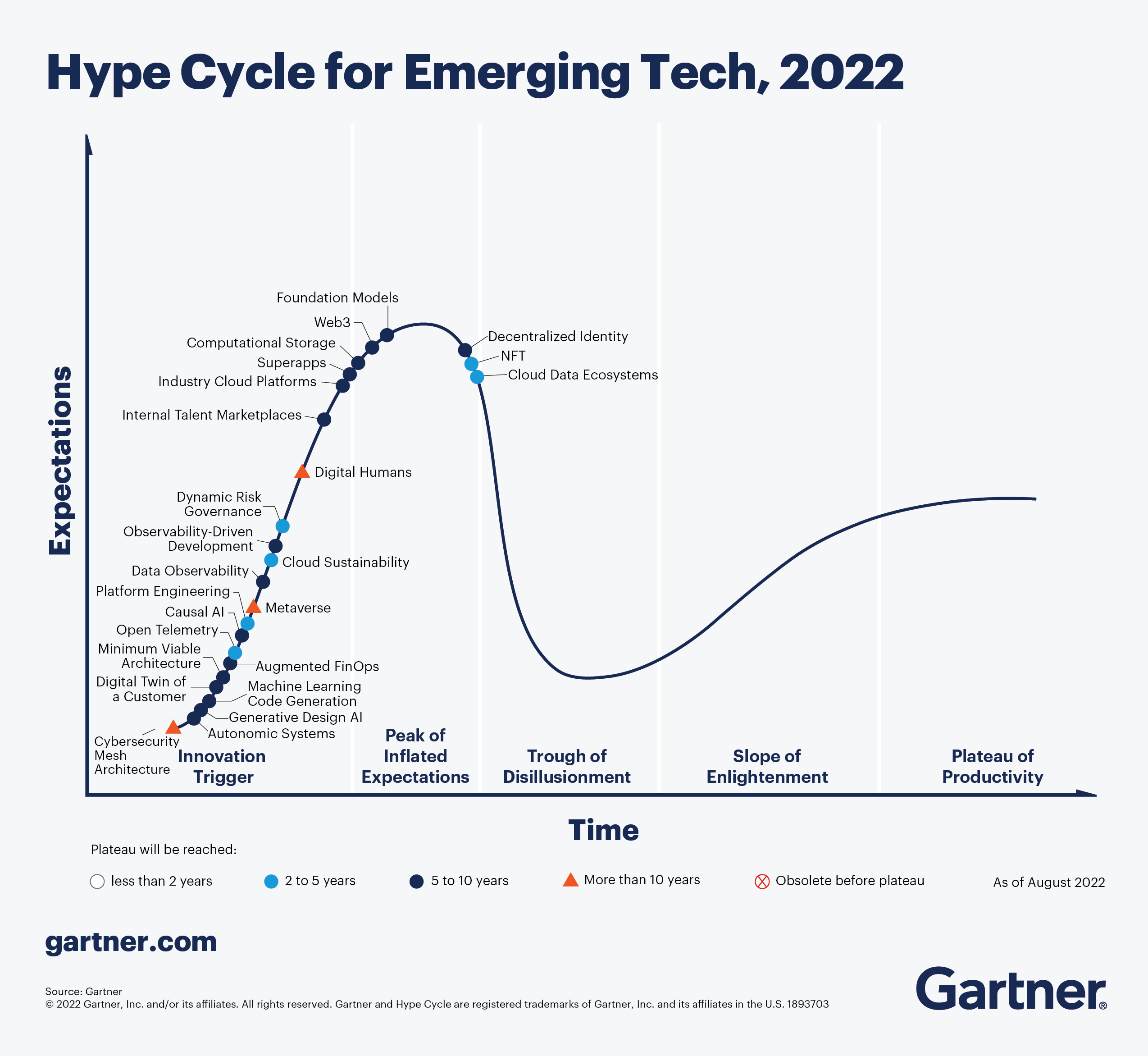The metaverse enters the Gartner hype cycle (but with a 10+ years outlook)
Ten days ago, the business analysts at Gartner released their “Hype Cycle” for 2022, and inside there are references to some of the technologies that we in the immersive community care about, in particular the metaverse.
Gartner Hype Cycle for Emerging Technologies
A small primer in case you don’t know what is the Gartner Hype Cycle. Gartner is one of the most respected business analysis companies in the world and every year it releases a graph of the disruptive innovative technologies to keep an eye on: the Hype Cycle. This graph shows what technologies may be disruptive for the short and long-term future, and so what technologies big companies should start working with because they could create opportunities for them or disrupt their own business. The graph is called the “Hype Cycle” because it puts the technologies on a curve that highlights the typical reception of a disruptive technology:
- At first, the technology gets discovered (Innovation Trigger)
- Then everyone starts getting hyped and think that that technology is going to disrupt everything and be useful for everything (Peak of Inflated Expectations)
- Then people realize that that technology can’t match the exaggerated expectations set up by the hype, so they are disappointed (Trough of disillusionment)
- Then the technology evolves and starts finding its real use cases (Slope of Enlightenment)
- In the end, the technology becomes useful and widely adopted. It is not special anymore, but mainstream (Plateau of productivity)
While you read those bullet points, probably you have also thought about the story of VR, hyped with the DK2 and Facebook’s acquisition of Oculus; rejected as a “fad” when the Rift CV1 and the Vive couldn’t reach the expected sales; started being considered again with the Quest, and now it’s quasi-mainstream, with kids asking a Quest 2 for Christmas to their parents.
The Hype Cycle gets released every year and is a graph that most business managers consider with great interest: if a technology is put there, it means that has a lot of potential for the future.
Gartner Hype Cycle for 2022
Gartner has examined more than 2000 technologies, and chose 25 that defined as “must-know innovations to drive competitive differentiation and efficiency”. These 25 special technologies have then been inserted into the hype cycle:

As we can see, there are some technologies that we all know: the metaverse, web3, NFT, and digital humans, to name a few. All these technologies are what we are dreaming of for the next 5 to 10 years. Immersive realities are so important for Gartner that it also identified them as one of the macro themes for 2022. The three macro-themes are in fact:
- Expand immersive experiences
- Accelerate artificial intelligence (AI) automation
- Optimize technologist delivery
You can read a bit more on Gartner’s 2022 Hype Cycle in its dedicated release blog post.
Analyzing the chart
It’s not the first time that Gartner puts immersive realities in its hype cycle, and also when it happened with AR and VR, I agreed on the fact that they should have been in the graph, but I didn’t agree with their position. For instance, saying that “Metaverse” is just rising now on the hype sounds a bit weird, considering that since Zuck’s announcement of Meta at Facebook Connect the web has been filled with posts about the metaverse and all the trillions it may give us. NFTs are reported as having just passed the hype, but actually, we are now into “the cryptocrash”, so in my opinion, they are more in the trough of disillusionment. I personally think that all these technologies should be more on the right than where they are, but probably Gartner has its own metrics to evaluate this position, or maybe it considers these technologies from different standpoints than mine (e.g. from the consumers’ point of view, or business owners’ point of view).

Anyway, it is super-important that metaverse, digital humans, web3, and other similar tech have entered this cycle: this means that Gartner validates how they can be disruptive for our future. This will lead to more companies wanting to enter the ecosystem, and making investments in our field. It’s a very important endorsement in my opinion, which can only bring positive consequences for all of us. I guess that many startups (mine included) will put this graph in their pitch deck.
It is relevant how two of the macro trends are immersive realities and AI. These fields are very connected, as NVIDIA managers told me when I spoke with them. AI for instance will lead to the creation of smart interfaces for our AR glasses, which will understand what is happening in our surroundings and suggest to us what to do. And AI/ML is at the basis of natural language processing, which is important to have digital humans we can interact with in XR. There are many joint use cases, and these technologies are relevant the one for the other, that’s why it is important they are both growing trends together.
I also underline how the outlook for these technologies is quite long. The metaverse has an outlook of 10+ years to be developed and become mainstream, exactly like digital humans, and a bit less than web3, which is predicted to have a 5-10 years timeframe. While we all know that business analysts are not good at making accurate predictions, I think that these are reasonable predictions with the data we have now. And they show once more that the road to the metaverse is still very long and complicated. Notwithstanding all the hype, the predictions of the trillions coming, and all people saying that we already have “metaverses” (I’m crying while writing this word) now, actually the real metaverse is coming in a lot of years because it requires many technology disruptions, plus its social acceptance.
As Jake Zim told me when I interviewed him, if we really believe in these technologies, we must commit to staying in the field for the next 10 years. Because, even if we have already walked a long road, we are still in the early days, and we need many years to see our dreams finally come true.
I’m in for this, what about you?
(Header image by Gartner)
Disclaimer: this blog contains advertisement and affiliate links to sustain itself. If you click on an affiliate link, I'll be very happy because I'll earn a small commission on your purchase. You can find my boring full disclosure here.



